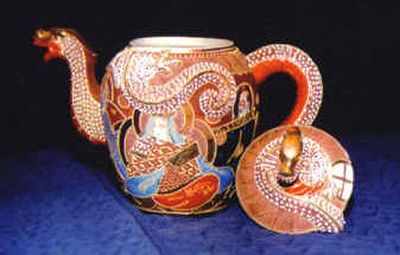Lithophanes give cups unique look

Dear Collector: I have a teapot, cups and saucers decorated with dragons that belonged to my late grandfather (he collected teapots). There is a woman’s face on the cups which is only viewable when held up to a strong light. Do you know where in Asia these things came from?
Your incomplete tea service has all the hallmarks of Japanese “Dragon Ware:” a bright, contrasting palette, raised decorations of applied slip called moriage (in this case the dragon’s scales) and lithophanes, a process of layering porcelain so a nearly invisible design is produced, which can be revealed against bright light (that’s how the ghostlike geisha girl appears on the cup bottoms). Invented by a Parisian in the 1820s, the use of lithophanes reached Asia in the latter part of the 19th century, where they have since been employed in numerous porcelain creations. Value on teapot is about $150, while each cup and saucer set is worth $25-$35.
Dear Collector: How much is this 1917D mercury dime worth?
The fellow with the winged cap isn’t Mercury, the messenger of the gods, but Liberty. The designer added avian appendages to epitomize “liberty of thought;” which, as we can see, didn’t fly. More than 9 million dimes were minted in Denver that year, and your coin, due to its high silver content, has a current value of $3.
Dear Collector: How old is our pelican cigarette lighter?
Listed in one reference as a Dodo (an extinct bird once found on Mauritius, an island in the Indian Ocean), your circa 1930 Ronson table lighter sure looks like a pelican to me. Anyway, if your chrome bird still strikes a spark, it could be worth $100.
Dear Collector: Is it possible this old Pinocchio book is worth something?
Selling for a dime when it was published by Grosset & Dunlap in 1939/40 for Walt Disney, this undersized format book could be worth $65 today if it’s in good condition.
Dear Collector: My mother insists the dish in these photos was made more than 100 years ago. She bases this on family history which says it first belonged to her father’s grandfather. Can you prove how old it is?
Judging by the backstamp (generic term used to describe the marks companies print, incise or paint on their products); I’d say that your piece came from Finland’s Arabia Porcelain Factory sometime in the 1880s.
Dear Collector: A friend told me that this “Official Badge, Campbell’s Kid club” button is valuable; is that true?
Value is relative; so if you think $100 for this 1940s pinback is a good price, then it’s valuable. Most people think the boy and girl are twins, not so! The artist who created the Campbell Kids in 1904, Grace Gebbie Drayton, didn’t give them names, necks or ears for that matter.
Dear Collector: What do you think is better to collect: football cards or teddy bears?
I’d go with the cards, many of which can sell for thousands of dollars. They take up less space, are easier to have appraised, and have more of a secondary market than teddy bears.
Recommended reading: “Collector’s Encyclopedia of Vogue Dolls,” Judith & Carol Stover (Collector Books, 2005, $29.95). “Vintage Christmas Ceramic Collectibles,” Walter Dworkin (Krause, 2004, $24.99). “B.J. Summers’ Guide to Coca-Cola,” B.J. Summers (Collector Books, 2005, $24.95).